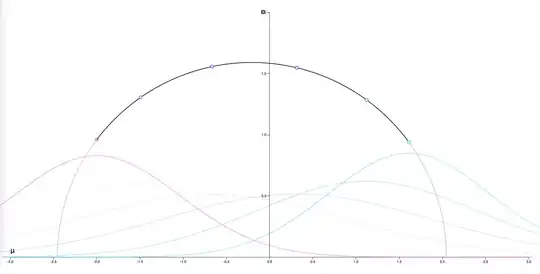I'm minimizing (through optimization using gradient descent) the energy $E(\gamma)=\int_{t_1}^{t_2} g_{\alpha\beta}(\gamma^{\alpha})'(\gamma^{\beta})'\operatorname{d}\!t$ of a curve using the inner product induced by the metric tensor. In my case the metric tensor is from information geometry (the Fisher metric) which is very simple for a univariate gaussian.
However, given that I'm using the Fisher metric as the metric tensor, I would expect that a geodesic of a univariate gaussian to follow an arc (e.g. shortest path between two univariate gaussian distributions is not a straight line as shown here). However, after optimizing the curve to minimize the energy, I'm always getting a straight line as distance between two univariate gaussians (using the same start/end points of the linked article from geomstats). Am I missing something ?
More details: I'm using a parametrized cubic spline curve (just as in here), just to give more details about which curve I'm using.
Trying to make the question more simple
I'm using the following metric (the Fisher metric as linked above) for computing the inner products:
$[ 1/scale, 2/scale ]$ (the matrix is 2x2, this is the diagonal, other elements are zero)
I have 2 parameters (mean, scale), and as you can see, the metric depends only on the scale. These parameters are parametrizing a univariate gaussian distribution (w/ mean and scale), and it is known that this metric induces an hyperbolic geometry (you can understand this better by looking at this animation, just click and drag and you will see the curve geodesic in the parameter space).
(note that y is my scale and x is mean, the dark black arc line is the geodesic, but this is not what I'm getting)
Now, if I minimize $E(\gamma)$ (using gradient descent) to optimize the curve parameters, what I get is a straight line connecting the parameters in the parameter space, while I would expect it to be curved as induced by the metric tensor.
